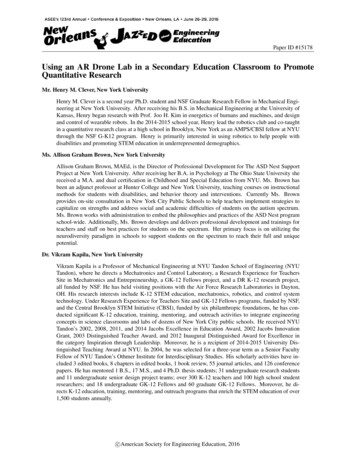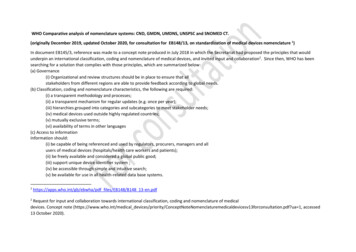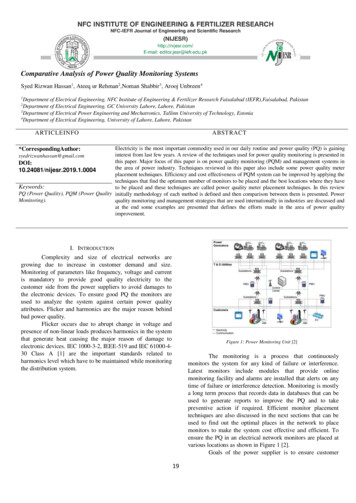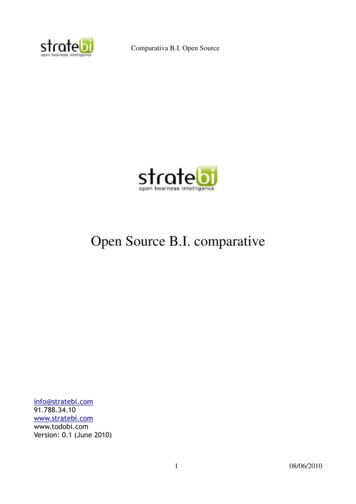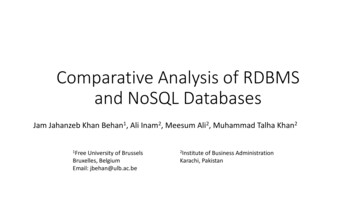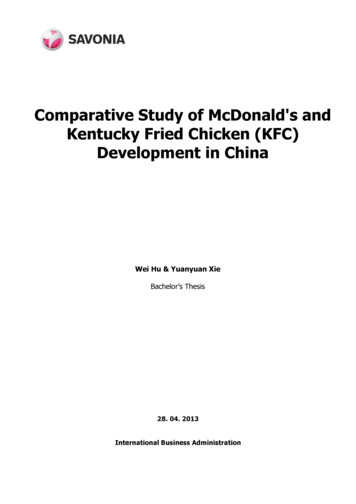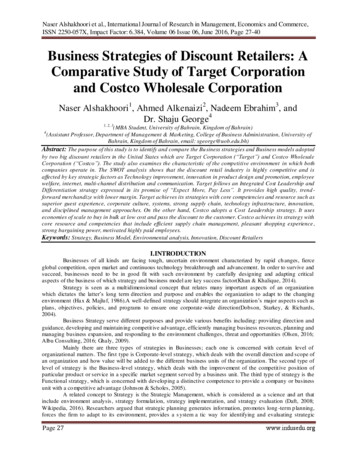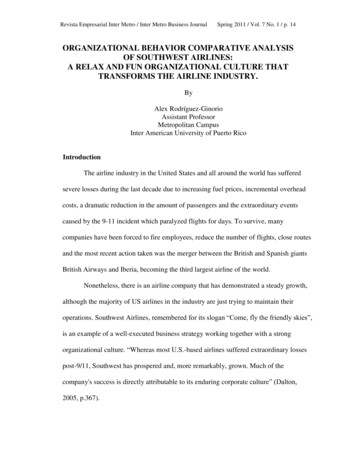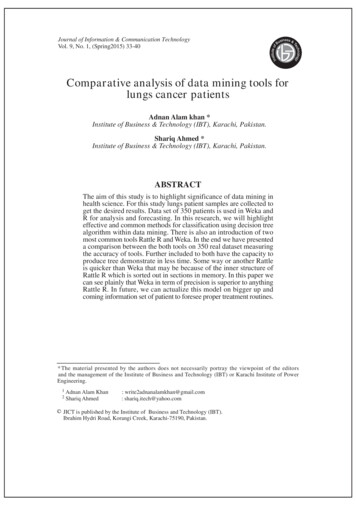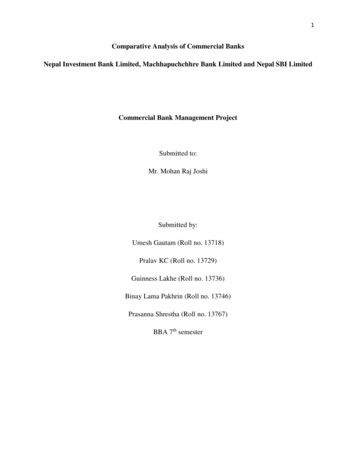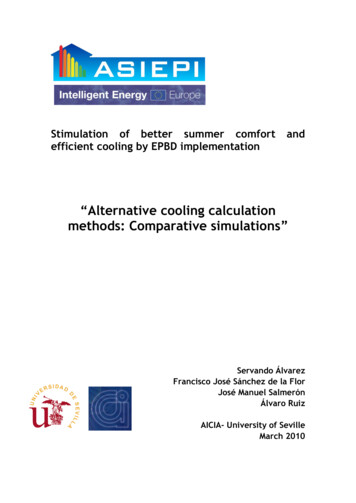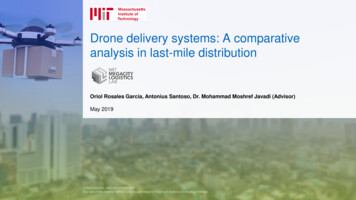
Transcription
Drone delivery systems: A comparativeanalysis in last-mile distributionOriol Rosales Garcia, Antonius Santoso, Dr. Mohammad Moshref Javadi (Advisor)May 2019CONFIDENTIAL AND PROPRIETARYAny use of this material without specific permission of Oriol and Antonius is strictly prohibited
Motivation and Background Methodology and Solution Analysis and Results2
E-commerce continues to outgrow offline retail revenue, fueling global parcel distribution particularly inlast-mile deliveryWorldwide retail revenues, 2015-20EUSD billionsCAGR2015-20Supply chain cost eliveryRemainingsupplychain costGrowing e-commerce business fuels global parcel growthLast-mile delivery shipping volume grows proportionally to e-commerce growthSOURCE: eMarketer – Worldwide Retail Ecommerce, Capgemini Research Institute, Last-mile delivery executive survey, Oct-Nov 2018, N 500 executives3
Customers service level expectations for last-mile delivery are rising whilemost of organizations are not readyTypical delivery ry2- 5 days1 day guaranteedSame dayInstant deliveryWithin 2-3 hoursguaranteedExpected marketgrowth% consumers thinkthis delivery speedcan increase loyalty% organizationsoffering this deliveryoptionSOURCE: MIT Megacity Logistic Lab research30%95%53%61%65%95%80%19%4
With the latest technological advancement, drone has emerged as aninnovative and viable business solution for commercial last-mile distributionCurrent phaseDrone technologyfully establishedCommercial playersadvance drone technologyDrone technology drivenby military R&DDrone technology has beenresearched and tested formilitary applications sincethe 1930'sMilitary era(1930’s - 2000)With significant costdecreases, drones becomeaccessible to everyone,creating new commercialdrone marketsCommercial era(2000 - 2015)Drone technologytakes offDrones emerge asinnovative and viablebusiness solutions (e.g.monitoring construction,inspecting turbine blades,surveying fields of crops andlast-mile delivery)Near future(2015- 2030)SOURCE: Press search: A brief history of drones – Imperial war museum -drones)Drones part of daily life andfully established in peopletransport, freight traffic, andother commercial use casesFar future(2030 )5
Drone will write the future of last-mile delivery: faster and cheaperSOURCE: NewtonX research -delivery/)6
Over the past 5 years, major logistic and e-commerce companies have beentesting drones as last-mile delivery systemCountryCompanyDrones providerDescriptionTimelineParcelcopter delivered 1 kilogram medicine2013 DecAlibaba partners with Shanghai YTO Express to delivertea to 450 customers around select cities in China2015 FebSF Express provides delivery services with Xaircraftdrones in China2015 MarFPS distribution completed first commercial deliveryusing UAV in Sheffield2015 MarFAA gives approval toGoogle’s Wing for DroneDeliveries in U.SRakuten delivers golf balls, sweets and drinks at thegolf course in Chiba2016 Apr2019 AprDomino delivers world's first ever pizza by drone inNew Zealand2016 NovJD has launched four drone bases in remote parts ofBeijing, Jiangsu, Shaanxi and Sichuan, making it easierfor local villagers to tap into China's largest sales festival2016 NovAmazon made its first drone delivery in UK2016 DecIceland largest ecommerce website AHA launcheddrones in partnership with Flytrex2017 AugRakuten provices drone delivery service inMinamisoma citySOURCE: Press search (DHL, Amazon, Alibaba, Bloomberg, JD, Domino, Flytrex, Rakuten), Deutsche Bank analysis2017 Oct7
Motivation and Background Methodology and Solution Analysis and Results8
There are various operating models for a drone-based last-mile delivery system, from pure dronedelivery to unsynchronized truck-drone delivery systemCustomerlocationDRONE DELIVERY SYSTEMS:A comparative analysis in last-mile distributionDepotTruckrouteTruckDronerouteDrone areaof reachDroneMODEL 1MODEL 2MODEL 3MODEL 4Pure drone delivery erShared Truck-DroneOur research evaluates the optimal design and operational performance of different drone delivery models9
ModelAlgorithmResults10
Algorithm Details Developed a variant of the Genetic Algorithm called Memetic inspired by evolutionNoNr. of Generations800 10001200Exit ationLocalsearchYesFinishConverged?300Population Size406080Elite Size of Population Fine tuning of algorithm by running multiple sensitivity analyses inorder to find the optimal set of parameters to achieve optimal results20% 40%Crossover Probability50%65%80%Crossover Segment123Mutation Probability10%15%20%Amount of 2-Opt40% Validated performance50%60% against standard academicbenchmarksOur best solution of eil51(Christofides 1969) within3.7% of best tour time11
Model variables Three objective functions are considered to minimize different goals:Last returnto depotTotal fleetcostTotal waitingtime Operational parameters can be adjusted to simulate different conditions: Nr. of DronesDrone SpeedDrone AutonomyDrone fixed costsDrone variable costs Nr. of TrucksTruck speedTruck thresholdTruck fixed costsTruck variable costs12
Motivation and Background Methodology and Solution Analysis and Results13
Analysis: Impact of adding a single drone to pure-truck delivery systemProblem instanceMinimum tour time, Minutes189.14179.78Probleminstance 3(150 customers– some areoutside dronerange)-5%120.40107.85-10%Probleminstance 4(150 customerswithin dronerange)14
Analysis: Drone delivery model performanceModel 2Drone-inner/Truck-outerModel 3Truck-inner/Drone-outerMin tour time(Minutes)Model 1Pure drone deliveryModel 4Shared Truck-DroneCustomers not served(# customers)Model 4 (sharedtruck-drone model)performs superior toother three models:Problem instance number(100 customers) Providing 100%coverage to allcustomers Reducingminimum tourtime as high as80%15
Analysis: Impact of operating parameters (# drones)Model 2Drone-inner/Truck-outerModel 3Truck-inner/Drone-outerModel 4Shared Truck-DroneIncreasing number ofdrones has positive impactsacross all drone deliverymodels:Customers not served(# customers)Min tour time(Minutes)Model 1Pure drone delivery# drones(1, 2, 3 drones) Increasing drones from 1to 2 reduces minimumtour time by 50% forModel 1, 2 and 3 Further increasingnumber of drones to 3reduces time by 30% forModel 1, 2 and 3 Model 4 also yieldedpositive impact by 4%16
ConclusionsInsightsBenefit erationalparameterPotential future areas ofresearch Adding a drone to a traditional last-mile delivery system that uses trucks only canreduce minimum tour time by up to 10% Model 4: shared truck-drone model — where truck and drone operate the samearea of service — performs superior to other three models, providing 100%coverage to all customers and reducing minimum tour time as high as 80% Higher number of drones yields better results than an increase in the speed orthe flight limit (battery life) of the existing drone fleet Add vehicle capacity and time delivery window to simulate more realisticallyConduct full cost benefit analysis by collecting actual fixed and variable costs17
Drone delivery systems: Acomparative analysis in last miledelivery systemQ&ACONFIDENTIAL AND PROPRIETARYAny use of this material without specific permission of McKinsey & Company is strictly prohibitedWORKING DRAFTLast Modified 5/20/2019 8:55 AM Eastern Standard TimePrinted
BACKUP
Motivation / BackgroundProblem statementWith the latest technological advancement, drone hasemerged as an innovative and viable businesssolution for commercial last-mile distribution.An efficient drone delivery system has to addressthe classic routing problem (VRP): “What is theoptimal set of routes for a fleet of drones toserve a given set of customers”Compared to traditional last-mile distribution with truck,drone has competitive advantages such as lower coststructure ( 80% cost reduction), reduced delivery time,farther reach in poor infrastructure areas and less CO2emission.It is estimated that around 86% of packages deliveredby e-commerce weigh less than 5 lbs., presenting a bigopportunity for drone delivery system. Over the past 5years, major logistic and e-commerce companieshave been testing drones as last-mile delivery systemIn addition, a drone routing problem needs toconsider several specific constraints, such asoperational limit of the drones (e.g. distancecovered, endurance, payload) and uniquetechnical characteristics of drone delivery(e.g. one package per time, no pick-up, no nighttime operation).This project will solve for optimal routes of truckand drones given drone operational limitation20
E-commerce continues to outgrow offline retail revenues and will reach 15% of global retail share until 2020CAGR2015-20Worldwide retail revenues, 2015-20EUSD ing e-commerce business fuels global parcel growthLast-mile delivery shipping volume grows proportionally to e-commerce growthSOURCE: eMarketer – Worldwide Retail Ecommerce l-Ecommerce-Sales)21
Last-mile delivery is the costliest step in supply chain, accounting more than40% of the total CE: Capgemini Research Institute, Last-mile delivery executive survey, Oct-Nov 2018, N 500 executivesLast-mile deliveryRemainingsupply chain cost22
23
24
25
26
27
28
29
30
31
32
Drones of JD (Chinese e-commerce giant)33
Literature review summary – Parcel and drones trendLiterature titleDrones meanbusinessSourceDeloitteUniversityPressInsights Managing theevolving skiesAn onslaughtof new rivals inparcel andexpressParcel delivery- The future oflast mileDeloitteBCG Air Navigation Service Providers (ANSPs) have been the primary source of oversight for safe and secure airplan travel for decades, but how will the flight paths ofthousands - possibly millions - of daily unmanned drone flights be managed? Unmanned aircraft system traffic management (UTM) will be needed to managevarious stakeholders (Drone operators, Communication system provider, Data service provider, Air navigation service provider)Currently introduction of UAV aircraft to airspace has been limited to visual line of sight (VLOS) operations. Only handful of countries (Australia, Canada, China,Denmark, NZ, Poland, South Africa, Switzerland and some US states) have taken measures to incorporate UAVs beyond visual line of sight (BVLOS) operation which includes package and food delivery Parcel and express startup funding has increased 20-fold from USD 0.2bn in 2014 to USD 3.9bn in 2016Investment breakdown by value chain: value chain orchestration (34%), end-to-end logistics (32%), last-mile delivery (29%), digital support (5%)75% of investment in last 5 years went to ChinaAmazon is trying to control its own logistic and transportation: operating its won airline fleet, experiments with delivery drones, starting up a logistic as a serviceoffering called Shipping with Amazon Cost of parcel delivery (excluding pickup, line-haul and sorting) is EUR 70 billion, with China, Germany and US accounting 40% of the marketGrowth rate in 2015 ranging between 7-10% in mature markets such as Germany and USA, and almost 300% in developing markets such as IndiaLast mile parce delivery cost is often reaching or exceeding 50%Trend 1: A growing group of consumers desires faster home delivery, yet most remain highly price sensitive: 70% customers prefer cheapest option of homedeliveryTrend 2: Autonomous vehicles including drones will deliver close to 100% of X2C and 80% of all itemsPublic opinion conering AV including drones has already started to shift - with 60% of consumers indicating they are in favor of or at least indifferent to dronedeliveryDrones is cost-competitive in rural areas, at only 10% above the cost of today's delivery modelDrones could offer a solution for smaller parcels delivery in rural areas - that is extremely costly to offer delivery within a specified time window or on the same daywith any kind of driving vehicle due to large distances that need to be covered to be in the right place at theright timeDrone limitation: (1) Limited load of 5 kg. Potential to increase to 15 kg, but 5% of items still weigh more than that (2) Require landing areaof 2m2Drones will deliver all time window and same day items in rural areas due to far fulfillment center from recipients (e.g. 75% of all recipients in US live in cities lessthan 50,000 inhabitants) McKinseyGlobal commercial drone market, the fastest growing segment for UAV, will exceed USD 20bn by 2021 - Goldman SachsNew FAA regulations have clarified rules for commercial drones, with FAA believing the rules could help lead to as many as 600,000 commercial drones inoperation by mid 2017DJI accounts for 70% of non-military drone market and its revenue skyrocket from USD 4mn in 2011 to USD1bn in 2015Piloting a drone is hard and inefficient. Hence to extract value, navigation software can improve versatilityWalmart expects to have computer vision enabled drones monitoring warehouse inventory by mid 2017, reduce manual inventory process of 30 day into single day 34
The theory behind it: Why Genetic algorithm worksGenetic Algorithms can find solutions to highly non-linear or discrete problems by emulating evolutionarymechani
21.05.2019 · Domino delivers world's first ever pizza by drone in New Zealand JD has launched four drone bases in remote parts of Beijing, Jiangsu, Shaanxi and Sichuan, making it easier for local villagers to tap into China's largest sales festival Amazon made its first drone delivery in UK Parcelcopter delivered 1 kilogram medicine Rakuten provices drone delivery service in Minamisoma city Iceland .
